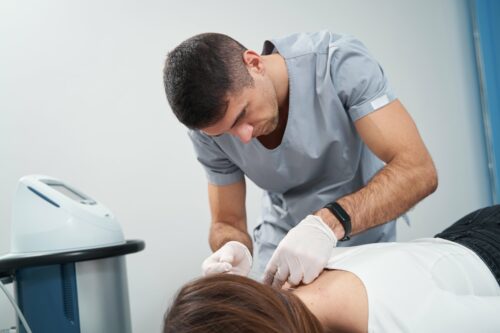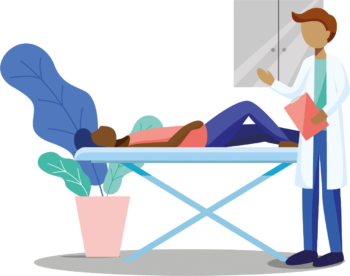By Christina DeBusk
Doctors of chiropractic are experts in addressing musculoskeletal conditions without the use of drugs or surgery. While best known for spinal manipulation, chiropractors may use a variety of evidence-based therapies to help their patients. Some DCs are even trained in acupuncture or work in integrative clinics where acupuncture is provided, giving patients access to two of the most effective non-drug approaches to pain management.
If acupuncture is on the list of your doctor’s services, here’s what you should know—including what it entails, conditions it may help treat, and who should avoid this type of treatment.

What Is Acupuncture?
“Acupuncture is probably the closest thing we do as chiropractors,” says Dr. Gary Estadt, DC, DACRB, an American Chiropractic Association (ACA) member who started practicing chiropractic 42 years ago and now teaches and lectures on acupuncture and dry needling.
During acupuncture, hair-like needles are inserted into specific points in the body to achieve various therapeutic effects. One of its effects is the release of tight muscles, making it easier for patients to move. Acupuncture also stimulates the release of certain hormones in the brain, providing benefits for some medical conditions.
Conditions Acupuncture Can Treat
One of the conditions treated by acupuncture is pain. “Acupuncture has a profound effect on pain,” explains Dr. Estadt. “It causes the brain to release some of the body’s natural pain relievers.” That makes it a way to get pain relief without popping any pills. And it can be used for pain that exists in one area of the body (called local pain) or pain that is more widespread (systemic or chronic pain).
“For chronic pain, you get a beneficial effect because you’re altering the brain chemistry,” explains Dr. Estadt. This has been supported by research using MRI images. “When you induce pain, certain pain centers in the brain light up on functional MRIs,” says Dr. Estadt. “When you needle the patient, they turn off.”
In addition to traditional body acupuncture, there are specific microsystems utilized in acupuncture. These microsystems are very effective at controlling pain. Acupuncture administered to the head (called scalp acupuncture) can be beneficial for treating neurological and psychological conditions, even helping to resolve addictions. Acupuncture performed on the ear (auricular acupuncture) can help you stop smoking and ease withdrawal from drugs.
Dr. Estadt adds that acupuncture also “works very well” for people who experience post-chemotherapy neuropathy. In fact, most cancer institutes have incorporated acupuncture as part of their treatment programs.
Acupuncture vs. Dry Needling: What’s the Difference?
Sometimes acupuncture is confused with dry needling, but they aren’t the same thing. Dr. Estadt shares that in dry needling, the needles are longer and placed based on myofascial trigger points, which are the same trigger points targeted in some cases when patients get a cortisone shot, for instance.
“Dry needling is the exact same thing without shooting in the cortisone,” says Dr. Estadt. “You needle the trigger point to get the muscle to twitch and release. Studies have shown that results are similar between dry needling and injection, which shows that the benefits come from inserting the needle into the muscle.”
This makes dry needling good for musculoskeletal complaints that involve a restriction in movement, such as frozen shoulder. But it’s also helpful if you’ve experienced trauma to the muscle, whether through a sports injury, a car accident, or due to a medical condition like arthritis.
Who Should Avoid Acupuncture?
Despite acupuncture’s many benefits, this treatment isn’t right for everyone. Dr. Estadt stresses that a proper case history and examination must be performed to determine if the patient is a candidate for acupuncture. Taking blood thinners or having recent joint replacement surgery might be contraindications for treatment.
Electroacupuncture, which involves adding electrical current to the needles, should be avoided by patients with electrically implanted devices (cardiac pacemakers, spinal cord stimulators, etc.). Some medical conditions require you to avoid acupuncture over certain regions of the body, like lymphedema, complex regional pain (CPRS), or cancer.
Combining Acupuncture and Chiropractic
While acupuncture and chiropractic services are two different treatments, they can be used together to potentially provide greater benefit. Acupuncture may even help when progress with chiropractic has stalled.
“I’ll have patients that I treat with chiropractic, and I hit a plateau with them,” says Dr. Estadt. “You alter your treatment plan and do acupuncture on them, and it gets them over that hump. You’ve released something that allows you to get past the sticking point.”
What to Expect
One concern that many have is, “Does acupuncture hurt?” Not if it’s done properly, says Dr. Estadt. Ancient Chinese proverbs describe it as “less than a mosquito bite.” You might feel a little bit of discomfort, but most patients find the experience relaxing.
The needles used for acupuncture are much smaller than those used for injections—or about the thickness of a hair. That allows them to enter the body without causing the same discomfort you might experience when getting a shot.
Each acupuncture session generally lasts between 15 and 30 minutes and you should begin to feel its benefits after just a few treatments. Talk to your chiropractor to learn what options exist for your medical condition or concerns.
Potential Side Effects
The risks of acupuncture treatment are minimal. The most common side effects are drowsiness, minor bleeding or bruising, or a temporary increase in symptoms. Dr. Estadt notes that some people feel more energetic after an acupuncture session.
Serious adverse side effects are rare. Fainting is also a rare occurrence following needling. This is the same response that causes people to faint at the sight of blood and is due to an overactive nervous system (vasovagal response). “I’ve only seen this once in my career,” says Dr. Estadt.
The risk of infection is low if you are receiving acupuncture anywhere in the Western hemisphere. The sterile needles are used only once and then discarded, says Dr. Estadt. This helps ensure patient safety.
How to Pick an Acupuncture Practitioner
If your chiropractor offers acupuncture, this is a good place to start. Otherwise, Dr. Estadt suggests that you “look for a practitioner that is licensed in your state and has experience treating your type of problem.” You can find an ACA chiropractor near you with the Find a Doctor tool on HandsDownBetter.org.
Christina DeBusk is a freelance contributor to Hands Down Better.
Reviewed by the ACA Editorial Advisory Board. The information in this post is for educational purposes. It is not a replacement for treatment or consultation with a healthcare professional. If you have specific questions, contact your doctor of chiropractic. To find an ACA chiropractor near you, click here. Please note, chiropractic is regulated by state law, and the scope of what chiropractors may treat may differ from state to state. Check with your state licensing board to learn more.



